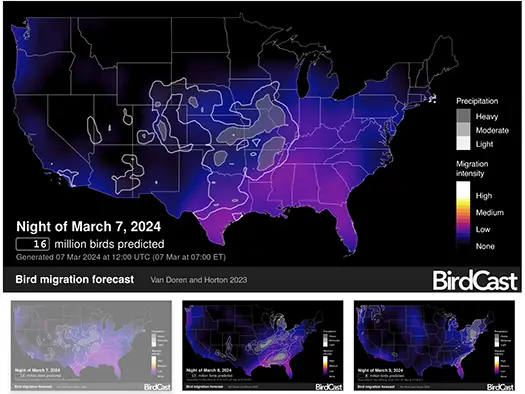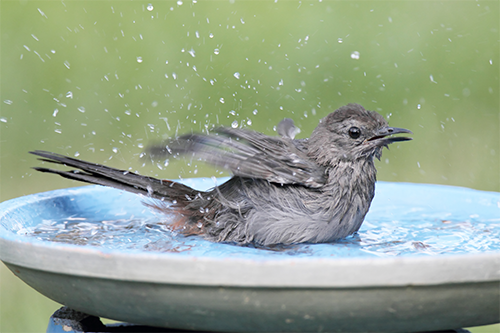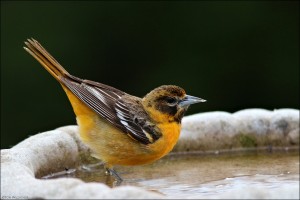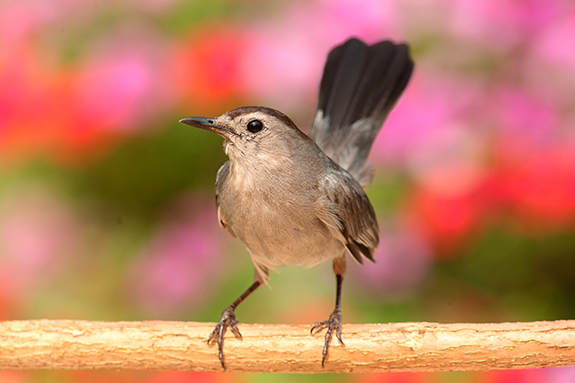The Best Time for Birding is NOW!
Are you ready for Spring Migration? THE very best time of the year! The reports are in and It is ON!!! Here are The Backyard Naturalist’s best tips and resources to help you get the most out of Spring Migration.
Migrants are arriving daily! The Backyard Naturalist has been eagerly checking progress via the Cornell Lab of Ornithology’s BirdCast and our own backyard.
The BirdCast interactive map tracks nocturnal Spring Migration in real time , thanks to the U.S. weather surveillance radar network. There are frequently updated regional statistics for each species as sightings increase and decrease.
Ever wondered how many birds are in the air at any given time? BirdCast has an answer for you.
The BirdCast team has added a new feature that is truly mind-boggling: the number of birds in flight at any given point in time. By the millions. This is just one feature among many that will continue to inspire every birder and citizen scientist year round.
See BirdCast’s ‘primer for using weather surveillance radar to study bird migration‘ to find out how truly powerful this resource is.

If anticipation isn’t already high enough for Spring Migration arrivals, Cornell Lab BirdCast also forecasts wild bird movements for the week ahead!
Now that you know who’s here and who’s on the way, here’s how you get started.
How to Get the Most Fun Out of Spring Birding
It’s Not Just About Food
The statistics and reports indicate your favorite out-of-town guests have arrived, but you may be wondering why you’re not seeing them at your backyard feeders. Please don’t feel snubbed or disheartened if your regular feeder contents aren’t attracting crowds of Orioles, Warblers or Vireos as they arrive. It’s not you. There are reasons for this and there are other things you can do to improve your chances to see these birds.
Many of these migrating songbirds won’t be tempted by your regular seed or suet feeders (Gray Catbirds, Rose-breasted and Evening Grosbeaks among the delightful exceptions), as they are seeking insects and berries to eat after their long journeys. Offer mealworms, jelly, or fruit as a temptation.
Meanwhile, you have absolutely nothing to lose by trying, as your regular visitors will definitely appreciate the treats. (Note: Please keep feeding all your regulars! And clean your feeders, too! Remember, it’s nesting season and that takes a phenomenal amount of energy!)
Hint: Water, Water, Water, WATER

We just can’t say it enough. Accessible water is always critical in any season! For a migrating bird, your bird bath is the best invitation you can give.
Hey, you’d want a cool drink and a bath, too, if you’d just flown 3,000 miles!
It’s time to clean out your bird baths, fountains or trays and keep them filled with fresh water. Keep an eye on the water level, as you may get some exuberant splashers! Check every day to make sure the water remains fresh, too.
Water! The Easy Jumpstart for Your Backyard Micro-Habitat
First off, if you don’t have a water source for wild birds in your backyard, what are you waiting for? This is one of the easiest and most important ways we can support the well-being of our wild bird population year round. Just add water! You will be rewarded with visits from wild birds that you’ll never see at a feeder… ALL birds need water and they need it ALL year round. (For more info, read our articles about Wild Birds, Water and Winter or Wild Birds, Summer and Water.)
Secondly, with a bird bath near your window, you’ll have an excellent opportunity to observe wild birds and their behavior up close. Don’t miss out on the fun!
Also, by adding just two other humble elements, every backyard can be a haven for wild birds—no matter the scale or level of effort! See our resource section on Backyard Habitats for some simple and easy tips to help get your habitat under way.
Here’s Where the Fun Really Starts
Watch and Be Ready
Make sure your binoculars and your camera are handy, right by the window. You may need to move quickly to get a good view. Can you identify your visitor? Knowing is part of the fun.
A good birding guide is indispensable and will really enhance your birding experience, so keep it handy, too!
Identifying Wild Birds by Sight (and Sound!)
Recommended Smartphone app:
The Cornell Lab’s Merlin Bird ID
Try the Merlin Bird ID Wizard. By answering three questions from Merlin, you’ll be offered a list of possible matches for the bird you’re seeing. Or, identify by sound if the bird isn’t visible.
For all levels of bird watchers from beginners to expert.
And it’s FREE!
Recommended guide books:
- National Geographic Field Guide to the Birds of Eastern North America – Jon Dunn, Jonathan K. Alderfer and Paul Lehman *
*This is our personal favorite, but another one might be the right one for you. When asked for a recommendation, we always say, “Find one that sings to you!”. The right field guide will be your best friend. - Sibley Field Guide to Birds of North America
- Peterson’s Field Guide to Birds of Eastern and Central North America
- Stokes Field Guide to Warblers – Donald and Lillian Stokes
- Sibley’s Warblers of Eastern North America (folding guide) – David Sibley
- The Warbler Guide (Princeton Press) – Tom Stephenson and Scott Whittle
- A Field Guide to Warblers of North America (Peterson Field Guides) – Kimball Garrett, Jon Dunn and Roger Tory Peterson
- The Young Birder’s Guide to Birds of North America (Peterson Field Guides) – Bill Thompson III
Excellent for junior birders.
The absolute best online resource for birders:
- The Cornell Lab of Ornithology‘s website, ‘All About Birds’
The More You Learn About Birds
The More Your Mind Will Boggle!
Once you’ve made an ID, finding out the distance this amazing bird has just flown to get to your backyard is astonishing and humbling to consider. Investigating further, and we promise you will be glad you did, you are bound to find other amazing things to ponder, even some unexpected wonders about wild birds you see every day in your yard!
You’re Sure They’re There Somewhere, But Can’t Spot Them
However, keep in mind, you may not be able to get a visual on a wild bird you suspect is nearby. For example, even though you are looking your hardest, you will likely hear a Baltimore Oriole before you see a Baltimore Oriole. Like many others, they tend to forage up higher and in denser foliage.

Water is the key! Your bird bath may tempt birds you’ll never attract with your feeders.
Female Baltimore Oriole visits Tom’s backyard bird bath.
Photo by Tom Wildoner, via flickr
We don’t recommend climbing trees to find out who’s visiting your backyard. There’s a better way to find out who’s there and what they’re up to — without disrupting their business or breaking your arm.
Listen and Locate
Bird sounds this time of year are beyond insane! As migratory birds head north, their vocalizations get more frequent and intensify as they get closer to their destinations. In addition to this building crescendo, our local residents who’ve been here the entire time are now singing with all their might to attract mates and define territories.
In fact, there’s a lot of communicating going on! If you’ve ever stopped to wonder what all the ruckus is about, identifying birds (and their behavior) by their unique calls is a challenge you’ll enjoy. (Especially enjoyable from your backyard hammock while your eyes are closed. Another great tip from your friends at The Backyard Naturalist! You’re welcome.)
Identifying Wild Birds by Sound
The Cornell Lab of Ornithology website hosts an awesome reference that will help you differentiate the varying calls of each species, with detailed information about wild bird songs—and the Cornell Lab of Ornithology Macaulay Library is the world’s largest archive of wildlife sounds.
Recommended Bird Sounds Collections on CD
- Bird Songs: East & Central (Peterson’s Field Guide)
- Birding by Ear (Peterson’s)
This is THE original that everyone emulated. - More Birding by Ear (Peterson’s)
Peterson ups the game with more. - Birds of Maryland and Delaware Field Guide (Includes Washington, DC and The Chesapeake) – This guide is most specific to our area. As fewer species are included, this may be the best choice for junior birders.
Recommended bird sound apps for your mobile device:
- Cornell Lab’s Merlin – It’s free! Merlin recognizes calls from over a thousand species, with extensive coverage for the US and Canada that includes 540 different species.
- iBird PRO and Chirp! USA – The Backyard Naturalist uses these two and highly recommends either of them.
- Apps by Peterson Guides
- Apps by The Audubon Society
Go Wild! Hit the Hotspots
Be where the action’s happening!
Our area’s natural spaces:
- Maryland Ornithological Society ‘Go Birding!’ Recommended Birding Sites and Habitats
- Guide to The Nature Conservancy preserves
- Maryland Ornithological Society For the More Serious Birder
- Maryland Ornithological Society Birder’s Guide to Maryland and D.C.
- Department of Natural Resources Map of Maryland’s natural areas
- Audubon‘s Birding in Maryland
- Audubon Society of Northern Virgina Guide to Area Birding Hotspots
- Maryland Office of Tourism ‘Top Spots for Nature Watching and Birding’
Join an organized field trip, bird walk or bird count.
The Backyard Naturalist’s Bird Walks with Pete Givan. Follow our Facebook page for birding opportunities.
- Maryland Ornithological Society Montgomery Bird Club Events
- Montgomery Bird Club Montgomery County’s Top Birding Spots
- Montgomery County Parks – Four nature centers offer a variety of programs and events year round. See the MontgomeryParks.org for more.
- Prince George Audubon Society Events
- Northern Virginia Bird Club Trips
For a fascinating, real-time overview of migrating birds on the move, don’t miss The Cornell Lab of Ornithology‘s Live Migration Map. Watch an animated view of three days of bird movement, as tracked by the US weather surveillance network. You can really get a sense of the amazing, and sometimes perilous, journeys made by our migrating birds twice a year!
Share the Experience
Wild birds flying thousands of miles to get here, defending territories, nesting, brooding… Does it get any better than this??!! It’s plenty of excitement to spark the interest of a young naturalist. A children’s guide to birding and a pair of inexpensive, junior binoculars might be just the right inspiration to get a potential Birder hooked! (See more for Junior Birders here.)
Share your sightings and photos with other Maryland birders on MD Birders Facebook page. Birding novices and experts alike post questions, advice, sightings, photos and more on this dynamic and very active Facebook page.
And we love hearing from you on The Backyard Naturalist Facebook page, too! We promise we’ll never stop liking your wild bird stories and photos! And, we’re always here if you have any questions. Just stop by the store or give us a call!
Happy Spring Migration, everyone!
Debi & Mike Klein and The Backyard Naturalist Staff






